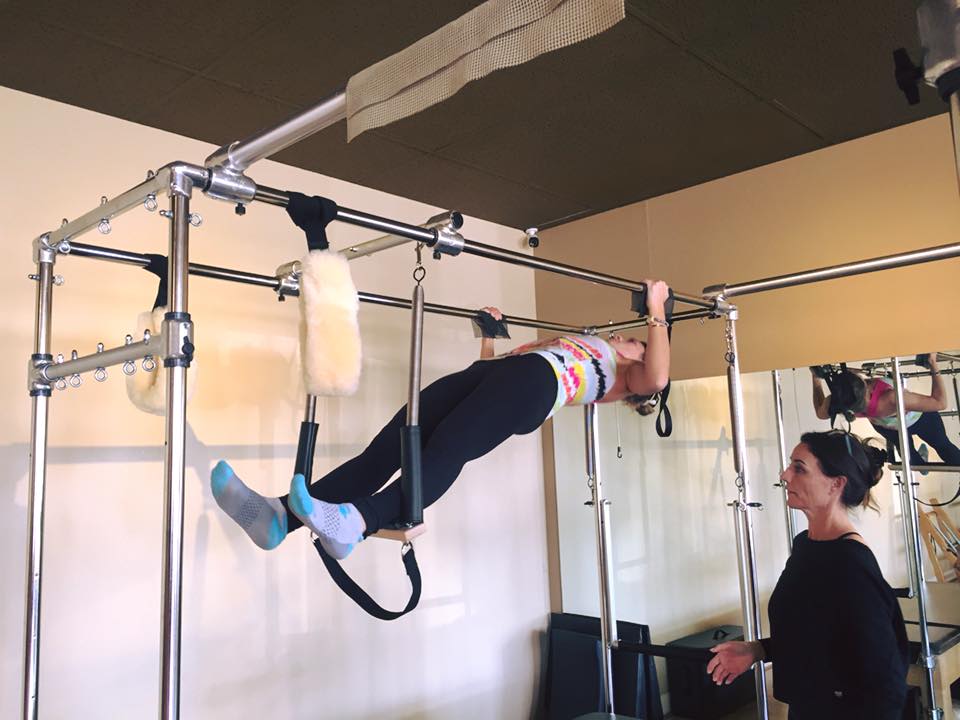Healing Back Pain
 Having been a Pilates devotee for almost 15 years, I never had back issues or pain. Thanks to Heather Obleada, I learned, starting at the ripe age of 15, the importance of a strong core, good posture and full body strength and mobility to prevent injury and chronic pain.
Having been a Pilates devotee for almost 15 years, I never had back issues or pain. Thanks to Heather Obleada, I learned, starting at the ripe age of 15, the importance of a strong core, good posture and full body strength and mobility to prevent injury and chronic pain.
It wasn’t until this past year that I began to experience mid-back and low-back pain. The culprit? My desk job. Previously, I had worked jobs where I could stand and move around. My time in graduate school also gave me a flexible schedule to be active, and only brief periods of sitting. Now, to combat the effects of sitting all day, I have found I need to spend extra time to taking care of my back body before, during, after and between my Pilates sessions in this season of life that is very desk-oriented.
For many of us, sitting for 8+ hours per day is an unfortunate reality. We sit in the car driving to work, we sit at our desks, computers and in meetings all day, and we sit in the car driving back home, or to pick up the kids, or to drive to Pilates class, or to run errands, etc. We hunch over screens, memos and..well…more screens all day long, at least five days per week.
So how can we make our sacred Pilates practice help reverse the mal-effects of all this sitting and hunching? Below are a few integral exercises you can do on your own (at home or at the office!) or incorporate into your studio routine with your instructor to ease back pain, open your chest and improve your posture.
- Pelvic tilt to Pelvic curl
Start in neutral spine lying on your back with your knees bent and feet flat on the floor with feet, ankles and knees hip-distance apart. Inhale. As you exhale, pull your lower abdominals in towards the spine, tilting your pelvis up while lengthening your spine into the floor. Here, the pubic bone is slightly higher than the hip bones. Inhale as you release back to the mat. If you want to take it into a pelvic curl, press down through your feet allowing the tailbone to curl up towards the ceiling as you pull your abdominals in. Inhale: Hips rise, lower spine, then middle spine, gently articulating as you rise. Resting on your shoulders at the shoulder blades, feel your abdominals and hamstrings engage, maintaining a straight line from hips to shoulders. As you exhale, use your abdominals to roll down one vertebrae at a time until the lower spine reaches the mat. Release to neutral spine as you inhale. Repeat 4-8 times, until you feel your back begin tosoften and become more mobile - Simple Chest Opener Doorway Stretch
Find a doorway opening. Standing tall and pulling in your abdominals, place your forearms/elbows at a 90 degree angle on the frame with your triceps parallel to the floor. Slowly walk forward until you feel a light stretch in the chest and shoulders. Hold this stretch for 30 seconds to 1 minute, and return to starting position.
- Supine Spinal Twist
Lying on your back on the floor with your arms out in a “T”, bring knees up to table top at a 90 degree angle. Pulling your abdominals in and resting the upper body comfortably on the mat, allow the knees (staying together) to drop over to one side. Anchor the opposing shoulder into the mat and breathe deeply, keeping your abdominals engaged. To enhance the twist, gently turn your head and neck to look the opposite way as the knees. Enjoy, and then gently switch sides. - Hamstring Stretch
There is a strong correlation between low back pain and tight hamstrings. Lying on your back on the mat, bring one leg up to the sky as you pull in the lower abdominals. Keep your opposite leg bent with you foot flat on the floor. With a theraband or yoga strap, cradle behind the foot, lengthening the leg toward the sky. To intensify the stretch, pull the leg towards you, gently until the stretch feels sufficient and satisfying. Switch sides.
These are just a few of the many exercises that can help to alleviate back pain and open the chest. For more, set up a session with any of the Iron Butterfly instructors to learn more exercises to make your days back pain free.
A few important notes/tips for pursuing Pilates with back pain:
-
- I am a Balanced Body certified Pilates instructor but am not a physical therapist or medical doctor. If you have severe back issues, you should work with your medical doctor and/or physical therapist to determine what exercises are safe for you.
-
- These exercises are meant to be a supplement to a regular Pilates practice. Doing these exercises alone will likely not be sufficient to treat back pain. As always with Pilates, it is a system and is most effective when fully integrated in a regular daily practice supervised by a certified instructor until you are proficient in alignment.
-
- Always inform your Pilates instructor of any injuries or back pain at the beginning of a session. If you are concerned with keeping up in a group setting, inquire about private or semi-private sessions tailored to your needs.
- Other considerations for those with back issues:
-
- Physical therapy – Ask about Iron Butterfly Pilate’s Physical Therapy offerings.
-
- Massage
-
- Acupuncture
-
- Integrative medicine – Ask about Iron Butterfly’s Integrative Medicine offerings.
-
- Foam rolling for myofascial release
-
- Gentle/restorative yoga and breathwork
- A new mattress or mattress topper – When did you last replace your mattress? Guidance says to do so every 5 and 10 years, depending on the firmness and quality of mattress.
-

Bonnie Efird is a guest contributor to Butterfly Buzz. This Charlotte native is a Balanced Body certified Pilates instructor living and teaching in Santa Monica, California. Bonnie takes refuge in helping others nurture wellness and healing in their lives through intentional movement. Outside of the studio, Bonnie is a comedy improviser, writer, PR professional and accomplished equestrian. Bonnie came to Pilates 15 years ago at Heather’s first iteration of Iron Butterfly to improve her posture and strengthen her core for her equestrian pursuits, and has been a devotee ever since.
